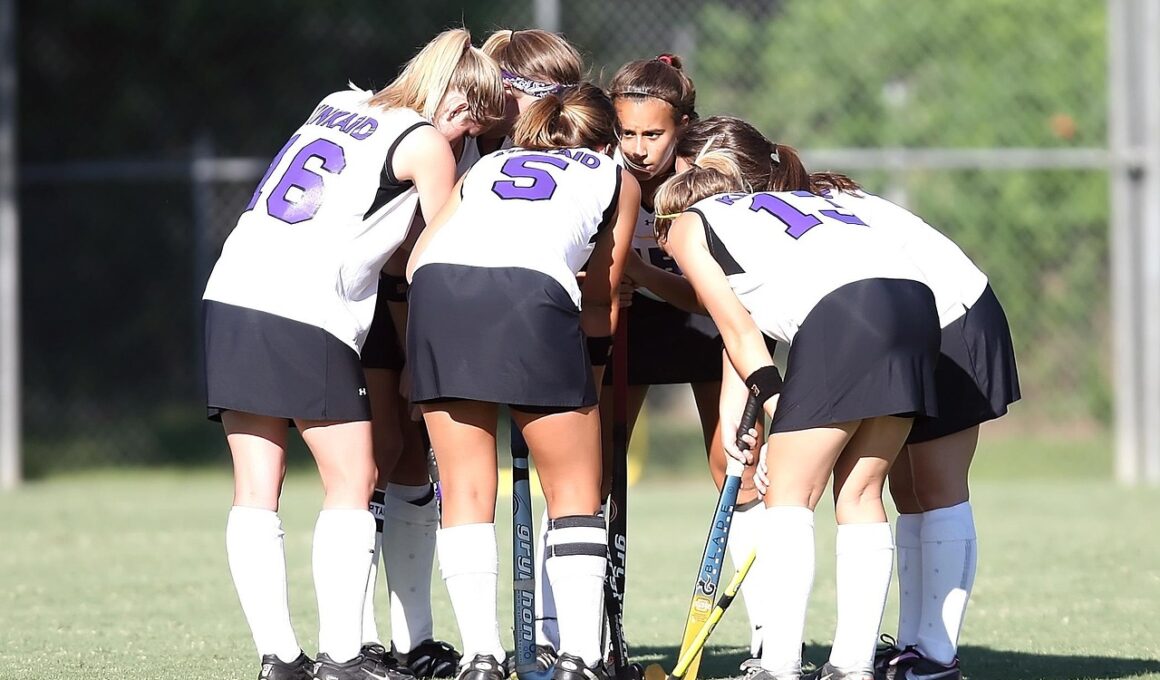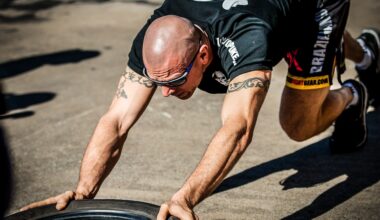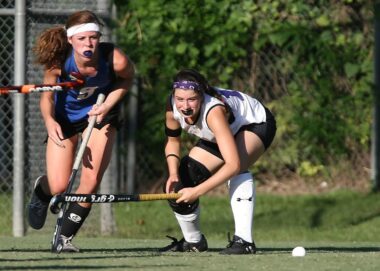Circuit Training Fundamentals for Field Hockey Players
Circuit training is an effective method for enhancing athletic performance in field hockey players. By implementing various exercise stations designed to develop strength, speed, and endurance, players can significantly improve their on-field performance. This training modality allows for both aerobic and anaerobic conditioning, critical for the high-intensity demands of hockey. Circuit training efficiently utilizes time, enabling players to work on multiple fitness components simultaneously. In a well-structured circuit, players rotate through different exercises while minimizing rest, thereby maximizing workout efficiency. This approach fosters muscular endurance and enhances overall fitness levels. Furthermore, circuit training can be tailored to individual player needs, which is particularly beneficial for teams with diverse skill sets. Coaches often design circuits that include agility drills, strength exercises, and sport-specific skills, ensuring a comprehensive training experience. Prioritizing technique during circuit training is vital to prevent injuries, allowing players to execute exercises properly. Participants should focus on controlled movements, adequate warm-up protocols, and cooldown stretches to support recovery. The versatility of circuit training makes it suitable for various training environments, whether on-field or in a gym, providing ample opportunities to elevate performance.
Incorporating Strength and Conditioning
Strength and conditioning are cornerstones of circuit training for field hockey players. Tailoring strength exercises to match the demands of the game allows athletes to develop the required muscle groups effectively. Focused strength circuits typically involve compound movements that engage multiple muscles simultaneously. Exercises such as squats, lunges, push-ups, and deadlifts should be integral parts of these routines. Bodyweight, free weights, and resistance bands can be utilized for optimal strength gains. Additionally, integrating plyometric movements fosters explosiveness, which is crucial for sprinting and quick directional changes needed during a game. Conditioning exercises, ranging from high-intensity interval training (HIIT) to continuous running drills, should be strategically included. Intensity and duration need to align with specific player roles; for instance, forwards may require shorter bursts of explosive strength, while defenders may benefit from longer endurance sessions. Circuit training allows flexibility in exercise selection, enabling players to target any specific physical area they wish to improve. Coaches should progressively increase the difficulty of workouts to continue challenging players and ensuring they avoid plateaus. Tracking progress and adapting circuits as players become stronger and fitter can help maintain motivation and drive results.
Another vital component of circuit training is agility, which is paramount for field hockey players. Agility drills improve players’ ability to change direction swiftly and maintain balance while doing so. Incorporating ladder drills, cone drills, and shuttle runs into the circuit training can significantly enhance agility. Players should practice quick footwork patterns and lateral movements, mimicking the movements they execute during match play. By regularly repeating these drills, athletes can develop faster reflexes and better coordination on the field. Agility training should also factor in reaction time, as players often need to respond instantly to opponents or game situations. Having a partner to create unpredictable movements ensures that players are prepared for real-game scenarios. The adaptation of agility training into circuit workouts enhances their overall performance and contributes to injury prevention. Strong emphasis must be placed on maintaining proper form to minimize the risk of strains or other injuries. The variety in agility drills keeps players engaged while developing crucial skills. Coaches should periodically assess agility improvements through timed drills or skill challenges to showcase advancement and maintain enthusiasm, ensuring players remain committed to their training regimen.
As endurance is a significant aspect of-field hockey, implementing conditioning stations into circuit training is essential. Endurance training allows players to sustain high levels of energy throughout a match, preventing fatigue. A well-rounded circuit should emphasize aerobic conditioning with running, cycling, or rowing activities designed to elevate heart rates. Longer intervals at moderate intensity can build the aerobic base, while shorter, high-intensity bursts help develop anaerobic endurance. Ensuring that the conditioning elements mirror hockey’s intense nature is imperative; drills should include alternating between sprinting and jogging to mimic the stop-and-go style of play. Furthermore, players need to pay attention to their breathing patterns to optimize oxygen intake during these sessions. Engaging in recovery protocols, like hydration and cooldown stretches, ensures muscles receive adequate care post-workout. Periodically assessing endurance through distance covered or timed runs allows players to evaluate improvements and identify areas for growth. Coaches must encourage players to push their limits while also promoting smart training practices to avoid burnout. Building endurance through circuit training not only improves physical stamina but enhances mental toughness, vital for maintaining focus and composure throughout games.
Sport-Specific Skill Integration
Integrating sport-specific skills into circuit training helps field hockey players translate their fitness improvements directly onto the field. Incorporating hockey drills within the circuit can include dribbling, shooting, and passing exercises that mimic real game scenarios. For instance, players might run through passing drills as they move between exercise stations to combine skill practice with physical conditioning. The goal is to reinforce muscle memory while building cardiovascular fitness simultaneously. Incorporating tactical decision-making components during circuits, such as navigating through cones while maintaining dribbling, enhances cognitive performance under physical stress. Coaches should design circuits that reflect game situations, encouraging players to adapt their skills to pressures they’ll face during matches. Utilizing small-sided games as a part of circuit training can also contribute significantly; they promote teamwork, strategy, and improve player awareness. Practicing specific game patterns enhances communication among teammates and fosters better gameplay. Focus on execution quality over quantity during skills training, ensuring each movement is practiced to perfection. Regularly adding new elements into these circuits not only keeps training fresh but also challenges players to adapt and improve continuously. This ensures players remain engaged and excited about their development.
Mental conditioning is an often-overlooked component in circuit training that plays a significant role in a player’s performance. Mental resilience can significantly impact how players cope with physical demands during gameplay. Coaches can introduce mental drills, such as visualization techniques alongside physical exercises, helping players prepare for the pressure of competition. Creating a positive training atmosphere that fosters self-belief enhances players’ confidence as they face challenges during matches. Mindfulness techniques incorporated during exercises, such as focusing on breath or maintaining presence, promote calm and composure in high-stress situations. Additionally, establishing team-building activities in circuit training fosters camaraderie, further enriching the training experience. Team-oriented circuits can improve communication and trust between players, leading to better on-field performance. Regularly discussing goals, achievements, and perspectives within the team empowers individuals to strive for personal and collective success. Moreover, players must develop strategies to cope with setbacks and utilize positive reinforcement to maintain motivation. Emphasizing mental aspects during circuit training not only boosts individual player confidence but also nurtures a strong team dynamic, creating a supportive environment that leads to exceptional outcomes during competitions.
Finally, tracking progress is essential in ensuring the effectiveness of circuit training for field hockey players. Regular assessments allow both players and coaches to identify strengths and areas needing improvement. Goal-setting should be a fundamental part of the training process; players can set realistic and measurable goals regarding fitness and skill benchmarks. Using fitness trackers and performance apps can aid in gathering data on heart rates, number of completed exercises, or time spent on particular drills. Regular feedback during training sessions helps players stay motivated and focused on improvements. Having scoreboards or performance metrics can foster a spirit of friendly competition, encouraging players to push beyond their limits. Coaches should facilitate discussions around progress and celebrate achievements, ensuring that each player feels supported and recognized. Adaptation of training plans should occur based on assessment results, keeping workouts challenging and tailored to evolving needs. This regular review encourages players to stay committed and engaged while pushing them toward reaching their potential. Building a culture of continuous improvement within the team will foster a resilient mindset, ultimately enhancing overall performance during competitions.





